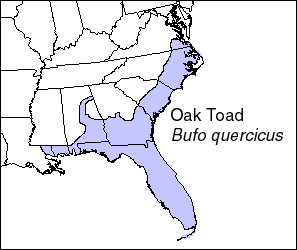Oak toad facts for kids
Quick facts for kids Oak toad |
|
|---|---|
 |
|
| Conservation status | |
| Scientific classification | |
 |
|
| Habitat range of A. quercicus | |
| Synonyms | |
|
Bufo quercicus Holbrook, 1840 |
The oak toad (Anaxyrus quercicus) is a tiny toad that lives in the southeastern United States. It's known for being the smallest toad in North America! These little toads are only about 19 to 33 millimeters long, which is less than two inches. They are found only in the coastal areas of this region.
Contents
What Does the Oak Toad Look Like?
The oak toad is easy to spot because of a light stripe down its back. It also has brown and black spots that can look different on each toad. A special feature is its large parotoid glands, which are bumps behind its eyes. These glands can release a mild toxin to protect the toad.
Male and female oak toads look a bit different.
- Males have a clear white belly. They also have a loose flap of skin under their chin. This skin expands into a vocal sac when they call.
- Females have dark spots on their belly. They do not have a vocal sac. Females are also usually a bit larger than males.
Where Do Oak Toads Live?
Oak toads live in the coastal parts of the southeastern United States. You can find them from eastern Louisiana all the way to southeast Virginia and south through Florida.
They like different kinds of places, such as:
- Sandy pine forests
- Open pine and oak woods
- Areas with sandy soil and grass
- Forests near the ocean
They especially like open pine forests with lots of grass. They are often found in moist, grassy spots near pine or oak areas with sandy soil. You can also see them near temporary pools of water and freshwater wetlands.
How Do Oak Toads Behave?
Oak toads are usually active during the day. They spend a lot of their time burrowed into the loose soil. This helps them stay safe and cool. During winter, they might stay in their burrow and hibernate.
Reproduction and Life Cycle
Oak toads breed in shallow pools of water that form after heavy rains. The male toad makes a chirping sound by expanding his vocal sac. This call helps him attract a female. The breeding season lasts from April to October, with most breeding happening early in the spring. Warm, heavy spring rains encourage them to mate.
A female oak toad lays about 300 to 500 eggs. She lays them in short strings of 3 to 8 eggs each. The eggs are tiny, about one millimeter wide. These strings are attached to plants, usually submerged grass blades. They are typically 4 to 12 centimeters under the water's surface. Laying so many eggs takes a lot of energy from the female toad.
The eggs hatch very quickly, in just 24 to 36 hours! The baby toads, called tadpoles, grow to about 18 to 19.4 millimeters long. They are grayish-olive or grape-green on top and purplish underneath. Their tails have 6 or 7 black marks.
Tadpoles change into tiny toadlets in about 4 to 6 weeks. This change is called metamorphosis. Young toadlets become adult toads when they are about 1.5 to 2.3 years old. In captivity, some oak toads have lived for four years, but the average lifespan is about 1.9 years.
What Do Oak Toads Eat?
The oak toad is a small toad that eats many different insects and other tiny creatures. Its main foods are ants, beetles, and spiders. It also eats other insects and arthropods.
The oak toad spends a lot of time looking for food. It uses its long, sticky tongue to catch its prey. Adult oak toads really love to eat ants. Even though ants are a big part of their diet, oak toads eat a wider variety of foods compared to many other frog species that live in tropical areas.
Who Eats the Oak Toad?
Snakes are the main predators of the oak toad. Hognose snakes are especially good at eating toads. Other snakes, like garter snakes, also eat them. Gopher frogs are another predator.
When an oak toad feels threatened, it has several ways to protect itself:
- It can puff up its body to look bigger.
- It can secrete toxins from its parotoid glands.
- It might urinate when scared.
- Male toads may even chirp when a predator is near.
- Even their eggs seem to have some toxic properties to keep them safe.
How Are Oak Toads Protected?
The International Union for Conservation of Nature says that the oak toad is a species of "least concern." This means they are not currently in danger of disappearing.
However, in some local areas, their numbers can become low. This happens when their habitat is changed by:
- New loblolly pine tree farms
- Urbanization (more cities and towns)
- Draining of water from their preferred wooded areas
These changes can make it harder for oak toads to find places to live and breed.
Images for kids
See also
 In Spanish: Anaxyrus quercicus para niños
In Spanish: Anaxyrus quercicus para niños






